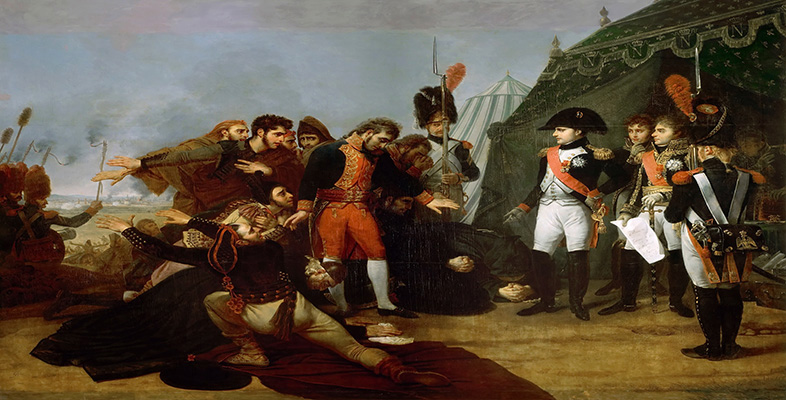3.4 Editing out warfare
It is important to note that the requirements of propaganda usually required the editing out of any too explicit reference to the violence of warfare. Thus, for example, though the commission for The Battle of Nazareth was cancelled mainly because Napoleon did not figure in the composition, it probably also had something to do with the gory nature of the scene. Critics of the time expressed disquiet about military paintings that (like Gros's sketch) dwelled on the actual killing involved, and thereby made it difficult for them to sustain a comforting belief in the noble ambitions that supposedly underlay French campaigns. They were too committed to this belief to be able to be explicit about the nature of their anxiety in their criticism, but it is not at all difficult to read between the lines.
Consider, for example, Pierre Chaussard's response to another painting by Gros, The Battle of Aboukir (see Plate 17 [Tip: hold Ctrl and click a link to open it in a new tab. (Hide tip)] ), which was exhibited at the Salon of 1806 and depicts a further episode from the Egyptian campaign. Chaussard praised the contrast that it offered between French ‘calm’ and ‘superiority’ and ‘the brutal rage and stupid ferocity’ of the Orientals. As such, it presented, in Chaussard's words, ‘the triumph of enlightenment and civilization over shadows and barbarism’ (quoted in Prendergast, 1997, p.97). However, he also criticized the way that, as he saw it, the overall order of the composition is disrupted by the chaos and carnage of the scene. Chaussard would clearly prefer to ignore the violence that underlay France's ‘civilizing mission’. Other critics of the time were even more disturbed by the painting. It was specifically the collapsing bodies of the Turks and the bright colours (the red perhaps too reminiscent of blood) that troubled them. What makes this example especially significant is that The Battle of Aboukir was not an official propaganda painting, but had been commissioned by one of the most famous of Napoleon's generals, Murat, who had led the charge which secured victory for the French at Aboukir in July 1799. He occupies the centre of Gros's composition.
Click to see plate 17 Antoine-Jean Gros, The Battle of Aboukir, 1806, oil on canvas, 578 x 968 cm, Châteaux de Versailles et de Trianon. Photo: Bridgeman Art Library
By contrast, the first group of works commissioned by Denon (in 1806) virtually excluded scenes of French soldiers actually engaged in combat, even though all but one had a military subject. The Battle of Austerlitz (see Plate 18) by Gérard, for example, which was exhibited to great acclaim in 1810, does not show the heat of battle, but rather the moment when news of the victory was brought to Napoleon. The other works commissioned by Denon typically showed either the prelude to battle or its aftermath, and glorified Napoleon not as a military commander but rather as an inspiring, compassionate and magnanimous leader. A case in point is Bonaparte Pardoning the Rebels of Cairo (see Plate 19) by Pierre-Narcisse Guerin (1774–1833), another painting of the Egyptian campaign, which was exhibited in 1808; as you will probably not be surprised to learn, this image of a forgiving conqueror glosses over the brutality with which the French repressed the uprising that took place in Cairo in 1798. In general, Napoleonic propaganda painting depicts the emperor as a ‘great man’, in accordance with the humanitarian and pacific values of the Enlightenment; it insists that, far from his being an aggressor, his endless wars are all motivated by a desire to establish peace.
Click to see plate 18 François Gérard, The Battle of Austerlitz, 1810, oil on canvas, 510 x 958 cm, Châteaux de Versailles et de Trianon. Photo: Bridgeman Art Library
Click to see plate 19 Pierre-Narcisse Guérin, Bonaparte Pardoning the Rebels of Cairo, 1808, oil on canvas, 365 x 500 cm, Châteaux de Versailles et de Trianon. Photo: Bridgeman Art Library
